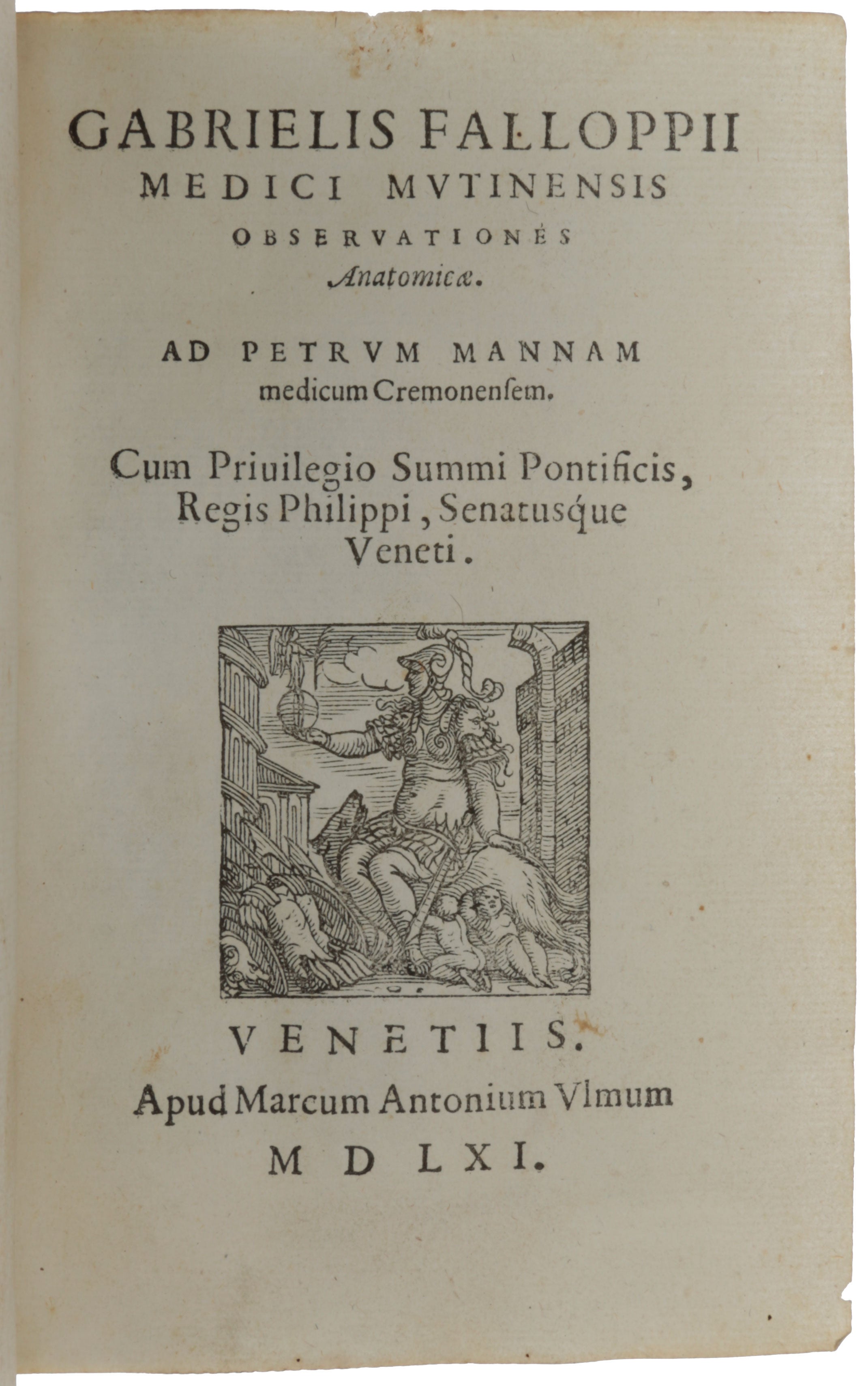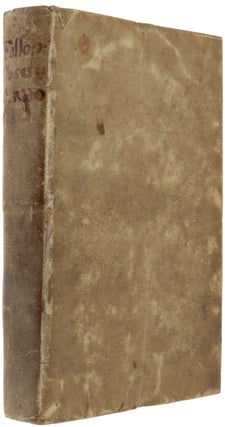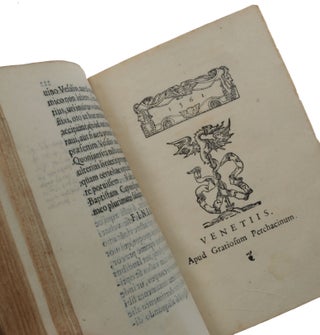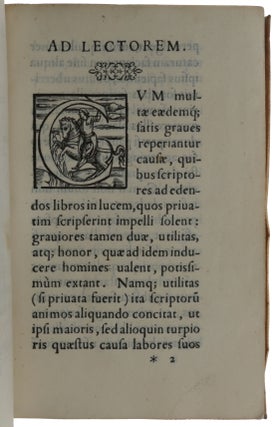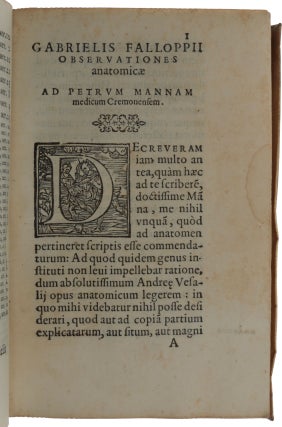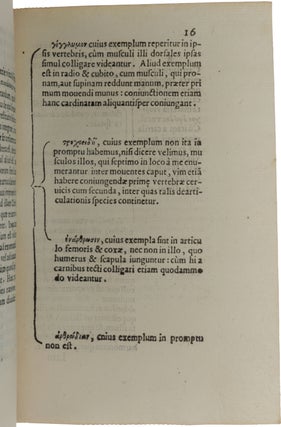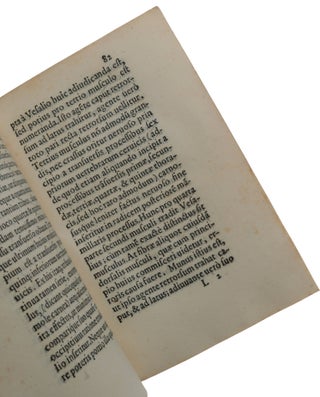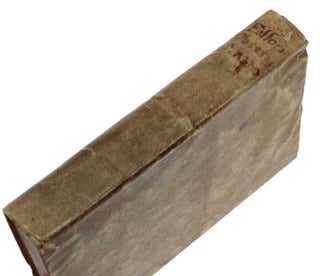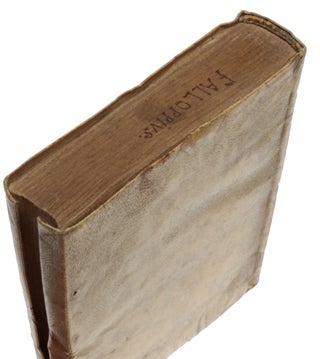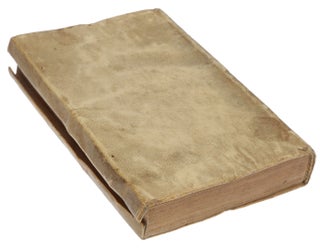Observationes anatomicae.
Venice: Marco Antonio Ulmo and Gratioso Perchachino, 1561. First edition, first issue, very rare, of the greatest Italian anatomical book of the sixteenth century, a detailed critical commentary on Vesalius’ De humani corporis fabrica. This is a pristine copy in an untouched contemporary binding. “The large amount of new material [in the present work] included Falloppio’s investigations of primary and secondary centers of ossification, the first clear description of primary dentition, numerous contributions to the study of the muscles (especially those of the head), and the famous account of the uterine (“Falloppian”) tubes, which he correctly described as resembling small trumpets (tubae). He also gave to the placenta and vagina their present scientific names, provided a superior description of the auditory apparatus (including the first clear accounts of the chorda tympani and semicircular canals), and was the first to clearly distinguish the trochlear nerve of the eye. Vesalius responded positively to Falloppio’s work with his posthumously published Examen on Falloppio (1564)” (Norman). “He was a careful dissector, a great observer, and an accurate recorder. He discovered and first described the chorda tympani and semicircular canals, correctly described the structure and course of the cerebral vessels, knew the circular folds of the small intestines. He enumerated all the nerves of the eye, and introduced a number of anatomical names. He is eponymously remembered by the Fallopian tube and the Fallopian aqueduct” (Garrison-Morton). ABPC/RBH record only five copies sold in the last 40 years, of which only the Norman copy was in an untouched contemporary binding (Christie’s, March 18, 1998, $21,850). “Of the various works by and attributed to Falloppio only the Observations anatomicae (1561) was published during his lifetime and can be said with certainty to be fully authentic. It is not, however, a general and systematic textbook of anatomy but an unillustrated commentary or series of observations on the De humani corporis fabrica of Vesalius, in which Falloppio sought to correct errors committed by his illustrious predecessor and to present new material hitherto overlooked. His criticism, contrary to a characteristic of that age, is temperate and friendly, so that it is not uncommon to find the object of the criticism referred to as the “divine Vesalius,” upon whose scientific foundations Falloppio, as a worthy successor, was willing to admit that he had based his own work. Since the Observationes anatomicae is not an all-inclusive study of anatomy, it never received the popular acclaim given, for example, to the De re anatomica (1559) of Colombo. It is, nevertheless, a work of greater originality. “Falloppio’s investigations were the consequence of dissection not only of adult human bodies but also of fetuses, newborn infants, and children “up to the first seven months, and in several beyond” (fol. 17v). He was thus able to make a number of observations and contributions to knowledge of primary and secondary centers of ossification. His most notable contributions of this nature were his descriptions of the ossification of the occiput (fols. 21r ff.), of the sternum (fols. 5l r-52v), and of the primary centers of the innominate bone (fols. 59r-60r). In his studies of the teeth Falloppio provided for the first time a clear description of primary dentition, the follicle of the tooth bud, and the manner of growth and replacement of the primary by the secondary tooth, as well as the first denial of the belief that teeth and bones are derived from the same tissues (fols. 39r-42v). Falloppio’s description of the auditory apparatus was superior to that of Vesalius and includes the first clear account of the round and oval windows, the cochlea, the semicircular canals, and the scala vestibuli and tympani (fols. 27r-30v). He also referred to the third ossicle of the ear, the stapes, actually already mentioned in print (Pedro Jimeno, 1549), but he declared that it had been first described orally in lectures by Giovanni Filippo Ingrassia during a visit to Rome in 1546 (fols. 25r-27r). “Not the least important of Falloppio’s contributions were those dealing with the muscles, among which were his relatively detailed account of the subcutaneous muscles of the scalp and face (fols. 62r-v, 63u-64r, 66u-68r) and his first description of the arrangement of the extrinsic muscles of the ear (fols. 62v-63r). In his investigation of the muscles of the head and neck he discovered and described the external pterygoid muscle (fol. 72v), analyzed the functions of the muscles of mastication (fols. 71 -73r), described the tensor and levaror veli palati (fols. 76u-77r), and redescribed with greater clarity some of the intrinsic muscles of the larynx (fols. 77u-79r). His greatest contribution to the study of the muscles of the head, however, was his account of the arrangement and functions of the muscles of the orbit (fols. 64r-66u, 68r-71 u). For the first time, he described the levator palpebrae, even though this honor was later to be claimed by Giulio Cesare Aranzi (1587). He observed the nictitating membrane of mammals, first described by Aristotle and thereafter seemingly disregarded. He recognized the compound action of the oblique muscles, and he was the first to describe and provide the name for the trochlea of the superior oblique muscle. In addition to further, lesser contributions to the study of the muscles of the trunk, he added notably to knowledge of the intrinsic muscles of the hand and of their action (fols. 101v-108v), separated the adductor mass of the thigh into its three elements, and noted the quadratus femoris (fol. 101v), which had been previously overlooked. “In considering the vascular system, Falloppio denied the long-held belief that the walls of the vessels were composed of fibers which by their direction controlled the flow of blood (fol. 114v). Curiously enough, however, he denied the existence of the venous valves (fol. 1 18v), which were actually known as early as 1546 and described by Vesalius (1555), and he failed to refer to the description of the pulmonary transit of the blood provided in detail by Colombo (1559). He did, on the other hand, give the first relatively adequate account of the distribution of the carotid arteries and of the cerebral circulation (fols. 121v-126r). He made a major contribution to knowledge of the nervous system through his clear distinction and description of the trochlear nerve (hitherto known only through the briefest mention by Alessandro Achillini [1520]); he traced it to its origin in the brain stem, demonstrated its exclusive termination in the superior oblique muscle of the eye, and satisfied himself beyond any doubt that this nerve was an entity deserving separate classification, and that it was “reflected on a cartilaginous pulley, and it turns the eye inwards” (fols. 155r-156r). Unwilling to upset the classic number (seven) and arrangement of the cranial nerves, he increased that number only to eight, although in fact he recognized eleven of the twelve cranial nerves. “Falloppio’s most important contribution to urology is his account of the kidneys, although it is always difficult to determine whether the priority is properly that of Falloppio or of his contemporary Bartolomeo Eustachi. With this understood, attention may be called to what seems to have been the earliest account of a case of bilateral duplication of the ureter and renal vessels: “Here at Padua I have observed and pointed out to my spectators double urinary passages and double sinuses in the middle of each human kidney, as well as many other things departing from the normal” (fols. 179v-180r). Failoppio seems, moreover, to have been the first to observe the straight tubules (fol. 180r-v) that are, however, eponymously named from Bellini’s more detailed description of 1662. and he noted the multiple calyxes of the human kidney (fols. 180v-181r). It was in the course of these remarks on the kidney that Falloppio criticized Vesalius for describing and illustrating in the Fabrica (1543) the unipapillary kidney of the dog instead of that of man—although he readily recognized Vesalius’ need to use the less fatty kidney of the dog in order to permit a better illustration of that organ’s structure. Falloppio further proposed the comparison of the renal papillae to small stills distilling off the urine from the blood (fols. 181v-l82r). He also first described the three muscle coats of the urinary bladder: “It possesses three tunics, as do the stomach and intestines”; and the bladder’s internal sphincter “formed by nature to contain the urine and prevent its being strained out” (fol. 182r). “Falloppio’s name is perhaps most closely associated with his description of the uterine or fallopian tubes, which in fact he described correctly as resembling small trumpets: “[The extremity] resembles the bell of a brass trumpet, wherefore the seminal passage, with or without its windings, resembles a kind of trumpet” (fol. 197r). Owing, however, to incorrect interpretation of Falloppio’s word tuba, some of the descriptive meaning has been lost in English. His description of the uterine tubes is sufficiently accurate in detail to justify their bearing his name; he furthermore described the clitoris (fol. 193r-v), asserted the existence of the hymen in virgins, a matter long under dispute (fol. 194r), coined the word ‘vagina’ (192r) for what had previously been called the cervix or neck of the uterus, and disproved the popular notion that the penis entered the uterus during coition (fol. 192v). He described certain vesicle-like structures filled with an aqueous fluid and others with a yellow humor (fol. 195u)—these may represent Graafian follicles or possibly a corpus luteum, and Falloppio’s would therefore be the second mention of these structures after a somewhat similar account by Vesalius (1555). “Gabriele Falloppio (1523? - 1562), son of Geronimo and Caterina Falloppio, was first educated in the classics, but after the death of his father and ensuing financial difficulties, he was directed towards a career in the church. With improvement in the family’s finances he turned to medicine, studying in Modena under Niccolo Machella and, according to the records, dissecting a body for his teacher in December 1544. Although still a student, but perhaps in need of funds, Falloppio began the practice of surgery but displayed so little aptitude for that subject—as demonstrated by the fatal outcome of a number of his cases—that he soon thereafter abandoned it and returned wholly to the study of medicine. There is a possibility that he spent some time at Padua under Giambattista da Monte and Matteo Realdo Colombo, the successor of Vesalius; and it can be stated with certainty that he studied for a period, about 1548, in Ferrara under the direction of “my teacher” Antonio Musa Brasavola and Giambattista Canano. “Falloppio was appointed to the chair of pharmacy in Ferrara and in 1549 accepted the chair of anatomy at the University of Pisa, where he was wrongfully accused of practicing human vivisection. During this period he spent some time in Florence dissecting the bodies of lions in the Medici zoo and thereby disproving Aristotle’s statement that the bones of lions are wholly solid and without marrow. Despite the charges against him, he was offered and accepted the famous chair of anatomy at Padua as a successor to Colombo. He took up his duties toward the end of 1551 and lectured and demonstrated with such success as to attract a number of later to be distinguished students, including the comparative anatomist Volcher Coiter. Falloppio was fully appreciated by the university’s authorities; he was regularly reappointed to the chair of anatomy until advancing pulmonary tuberculosis first limited his activities and finally killed him” (DSB). “Falloppio was a poor man and published this book at his own expense” (Heirs of Hippocrates). This first edition was followed by a second in 1562 which was issued in Cologne, Paris and Venice. The Venice issue was made up of the sheets from the first printing but with a new title-page and the errata corrected; the Cologne and Paris printings were reset. Censimento 16 CNCE 18526; Durling 1440; Eimas 331; Norman 757; Lilly, Notable Medical Books 39; Heirs of Hippocrates 331; Garrison-Morton 1208; Osler 593; Waller 2935; not in Wellcome, which has only the 1562 edition.
8vo (155 x 100 mm), ff. [viii], 222, [2, the last blank], printer’s woodcut devices on title and at end. Contemporary vellum with yapped edges, upper and lower edges blind ruled, author’s name in manuscript to top edge of text block.
Item #5352
Price: $45,000.00

